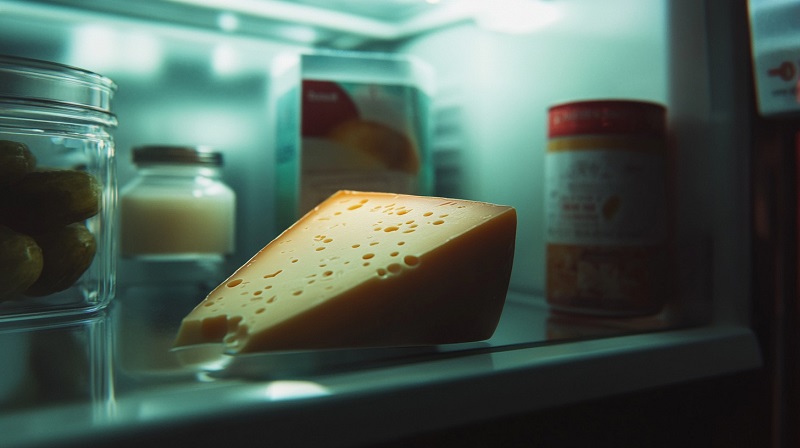A date printed on the label does not always tell the full story. Some cheeses can stay safe long past expiration. Others turn dangerous within days. Confusion builds when mold appears, or the smell changes slightly. Many people end up wasting perfectly edible cheese. Others take risks without knowing the signs of danger.
Food safety depends on texture, type, storage, and visible signs. Not all cheese behaves the same way. One slice might stay safe. Another could carry harmful bacteria. Clear signs help avoid both waste and risk. Every detail matters.
Confused by Cheese Expiration Dates? Here’s What You Really Need to Know

Many people rely only on the date printed on a package when choosing to buy a product. Some throw it away without a second look. Others take a chance and use it even if the expiry date is near or already here. The reality lies somewhere in between.
You will usually see two types of dates: best-before and use-by. They do not mean the same thing. Best-before refers to when the cheese will taste its best. It does not automatically mean it becomes unsafe after that day. Use-by, on the other hand, tells you when safety may become a concern. You should never ignore a use-by date, especially on soft or fresh cheese.
Cheese does not expire in a simple way. Hard cheeses like cheddar and Parmesan have low moisture. They can last longer. Fresh or soft types like mozzarella or ricotta go bad fast. One wedge can sit safely for weeks. Another can turn dangerous in days.
Fridge conditions matter too. A well-sealed cheese stored below 40°F may outlast its label. One left uncovered or near the door may spoil early.
Key point: No label knows how you stored your cheese. Dates help, but your eyes, nose, and common sense matter more.
How Long Different Cheeses Stay Safe?

Every cheese has its own shelf life. You cannot use the same rule for all of them. Texture, moisture, and how the cheese is made all affect how long it stays safe. Some types hold up well even after the printed date. Others turn risky much faster.
Hard Cheeses Stay Safe the Longest
Cheddar, Parmesan, and similar types are aged and low in moisture. That slows bacteria growth. If stored properly, they often stay safe weeks beyond the best-before date. If mold appears, you can usually cut away the bad part. Slice at least one inch around and below the mold. The rest is usually safe to eat.
Semi-soft and Soft Cheeses Spoil Faster
Cheeses like mozzarella, havarti, or brie contain more moisture. That speeds up spoilage. Mold spreads easily through them. Once you see mold or notice a bad smell, the entire block or wheel must go. Even if it looks fine, do not eat soft cheese past its use-by date.
According to the FDA, soft cheeses like queso fresco and ricotta carry a higher risk of Listeria and must be stored below 40°F. They recommend avoiding unpasteurized versions and discarding any cheese left out for over two hours.
Fresh Cheeses Are Most Likely to Go Bad Quickly
Cream cheese, ricotta, and cottage cheese carry the highest risk. They do not age well. They have almost no barrier against bacteria. Once opened, they spoil within days. Never eat fresh cheese that has gone past its use-by date. If the container bloats, smells sour, or looks separated, throw it out.
Quick tip: The softer the cheese, the shorter the safe window. Trust your senses, but follow the date on soft and fresh cheese without exception.
How to Spot Spoiled Cheese Before It Makes You Sick

You do not need a lab test to know when cheese has gone bad. The signs are usually clear if you know what to look for. Trust your senses. They can protect you from eating something harmful.
Mold: Not Always a Deal Breaker
Mold on hard cheese does not always mean you must toss the whole block. If it is a firm type like cheddar or Swiss, cut off at least one inch around and under the mold. Use a clean knife and make sure the mold does not spread deeper.
Texture: Slimy, Dry, or Cracked Means Trouble
Cheese that turns slimy should never be eaten. That slick layer means bacteria are growing. If a cheese that was once creamy becomes dry, cracked, or gritty, it is no longer safe. Excess liquid pooling in the container is another warning sign.
Smell: Trust Your Nose
Cheese has strong smells, but those smells should be familiar. If it suddenly smells sour, bitter, or like ammonia, it has turned. A sharp or chemical odor that was not there before means it is time to let go.
Do not taste cheese to check it. If you are unsure, use your eyes, fingers, and nose. A small bite of spoiled cheese can cause days of illness.
What Can Go Wrong If You Eat Spoiled Cheese?
Cheese may look harmless, but when it turns, it becomes a real health risk. Eating spoiled cheese is not worth the gamble. Bacteria that grow in bad cheese can trigger serious illness, especially in people with weaker immune systems.
Different bacteria cause different conditions. Each comes with its own symptoms and risks.
| Illness | Bacteria | Common Symptoms | Possible Risks |
|---|---|---|---|
| Listeriosis | Listeria monocytogenes | Fever, nausea, muscle aches | Miscarriage, meningitis |
| Salmonellosis | Salmonella | Diarrhea, cramps, fever | Dehydration, arthritis |
| E. coli infection | Escherichia coli O157:H7 | Bloody diarrhea, cramps, vomiting | Kidney failure |
| Brucellosis | Brucella | Fever, fatigue, joint pain | Chronic infection |
| Botulism | Clostridium botulinum | Blurred vision, muscle weakness | Paralysis, breathing failure |
https://www.youtube.com/watch?v=-LSEG4HFAd0&pp=ygUSRWF0IFNwb2lsZWQgQ2hlZXNl0gcJCb0Ag7Wk3p_U
Foodborne Illness Is a Real Threat
Spoiled cheese can carry dangerous bacteria like Listeria, E. coli, and Salmonella. These pathogens thrive in warm or moist conditions, especially in soft and fresh cheese that has gone past its safe date. Ingesting them can cause vomiting, diarrhea, stomach cramps, or fever.
Symptoms can appear hours or even days after eating the spoiled cheese. In some cases, the illness becomes severe and requires medical attention. For young children, older adults, pregnant women, and anyone with a compromised immune system, the danger is even higher.
Small Amounts Can Still Be Risky
Even a small amount of contaminated cheese can carry enough bacteria to make you sick. Unlike some other spoiled foods, cheese does not always show extreme signs of spoilage before the danger sets in.
How to Store Cheese the Right Way?
Good storage makes all the difference. Even the best cheese will spoil early if handled the wrong way. Proper temperature, wrapping, and placement inside your fridge all play a role in keeping cheese safe.
Temperature Always Comes First
Cheese must stay cold. Always store it at or below 40°F. That slows bacteria growth. Never leave cheese out for more than two hours. If it sits in a warm room or car, the clock speeds up fast. Do not trust it after that.
Wrap It Right
Hard cheese needs to breathe a little. Wrap it in wax paper first, then place it in a loose plastic bag or a sealed container. That keeps moisture balanced without trapping air.
Soft cheese and fresh cheese must be sealed tightly. Keep them in the original packaging or a clean airtight container. Exposure to air will speed up spoilage.
Store It in the Coldest Spot
Keep cheese in the main compartment of your fridge, not in the door. The door is too warm and unstable. Place it on a middle or lower shelf where the temperature stays steady.
Extra tip: Do not pre-slice cheese for storage. Slicing exposes more surface area to air and bacteria, which shortens its life.
When to Throw Cheese Away?

You do not need to guess when it is time to toss cheese. There are reliable signs that make the decision simple. Safe cheese always looks, smells, and feels like it should. Once that changes, so should your plan to eat it.
Mold in the Wrong Place
Hard cheese can handle surface mold if trimmed properly. Cut at least one inch around and below the moldy spot. Use a clean knife and avoid touching the mold with your hands.
But soft, shredded, or sliced cheese must go if mold appears. In those cases, the mold spreads fast and deep. No trimming can make it safe again.
Off Smell or Slimy Feel
If the smell is sour, bitter, or chemical-like, throw it out. Cheese that feels slimy or sticky is already breaking down. Texture tells the truth even before smell or taste changes.
Last Words
You do not need to panic every time a date has passed, and you do not need to take risks either. If a cheese looks fine, smells normal, and matches its usual texture, it is probably still safe—especially if it is hard or aged.
Soft or fresh cheese, on the other hand, needs a stricter line. Once it turns, there is no saving it. Pay attention, trust what you notice, and never rely on the label alone.
Hi there, my name is Kelly Barlow and kellytoeat.com is my blog. Here, I write about various recipes I want to reccommend to readers.
I try to find the best possible recipes that can attract the attention of readers, and at the same time, I strive to write it in the most engaging manner possible.
When I was younger, I wanted to become a chef. Sadly, it wasn’t meant to be, but at the very least, I write about it.
